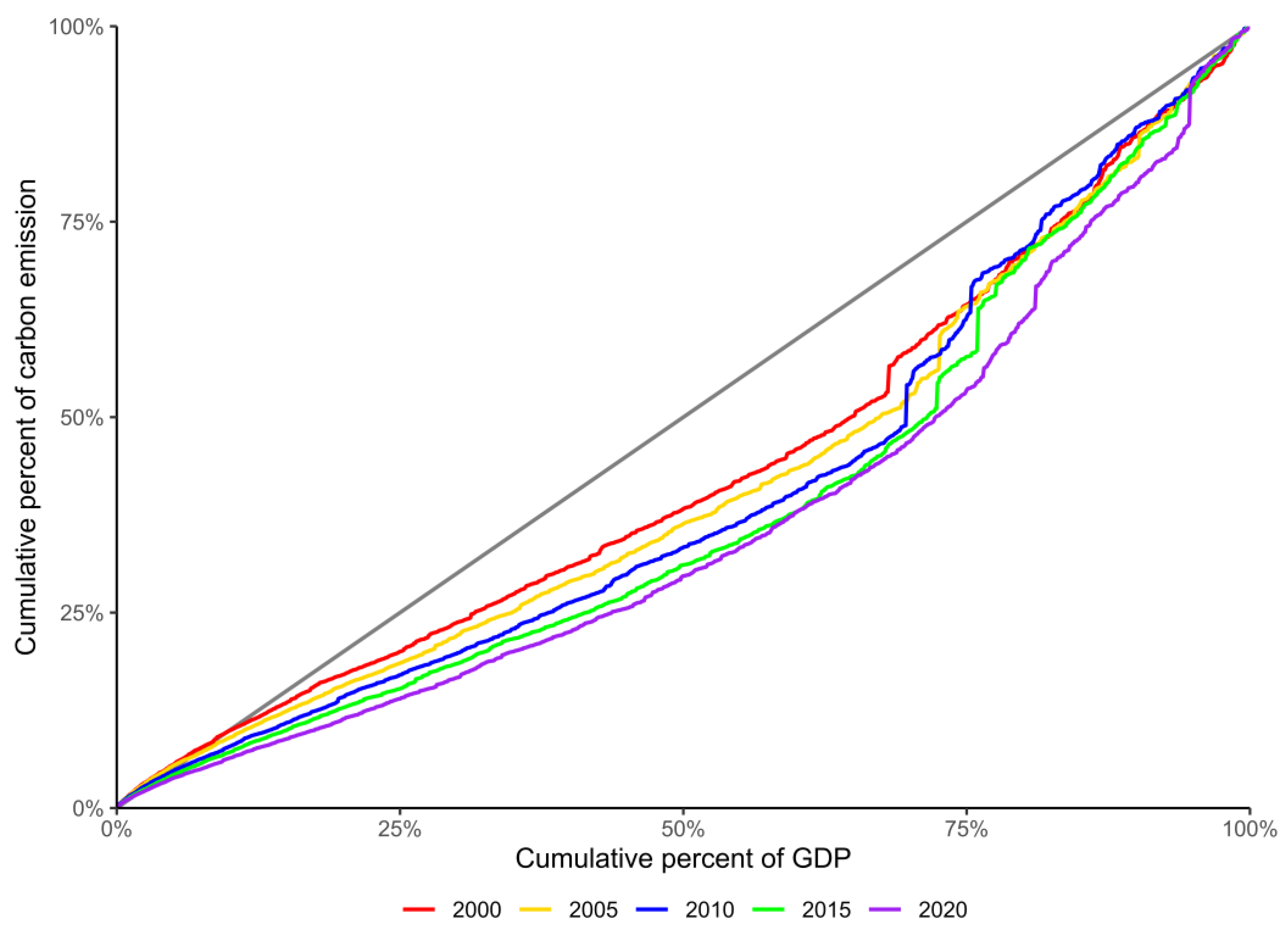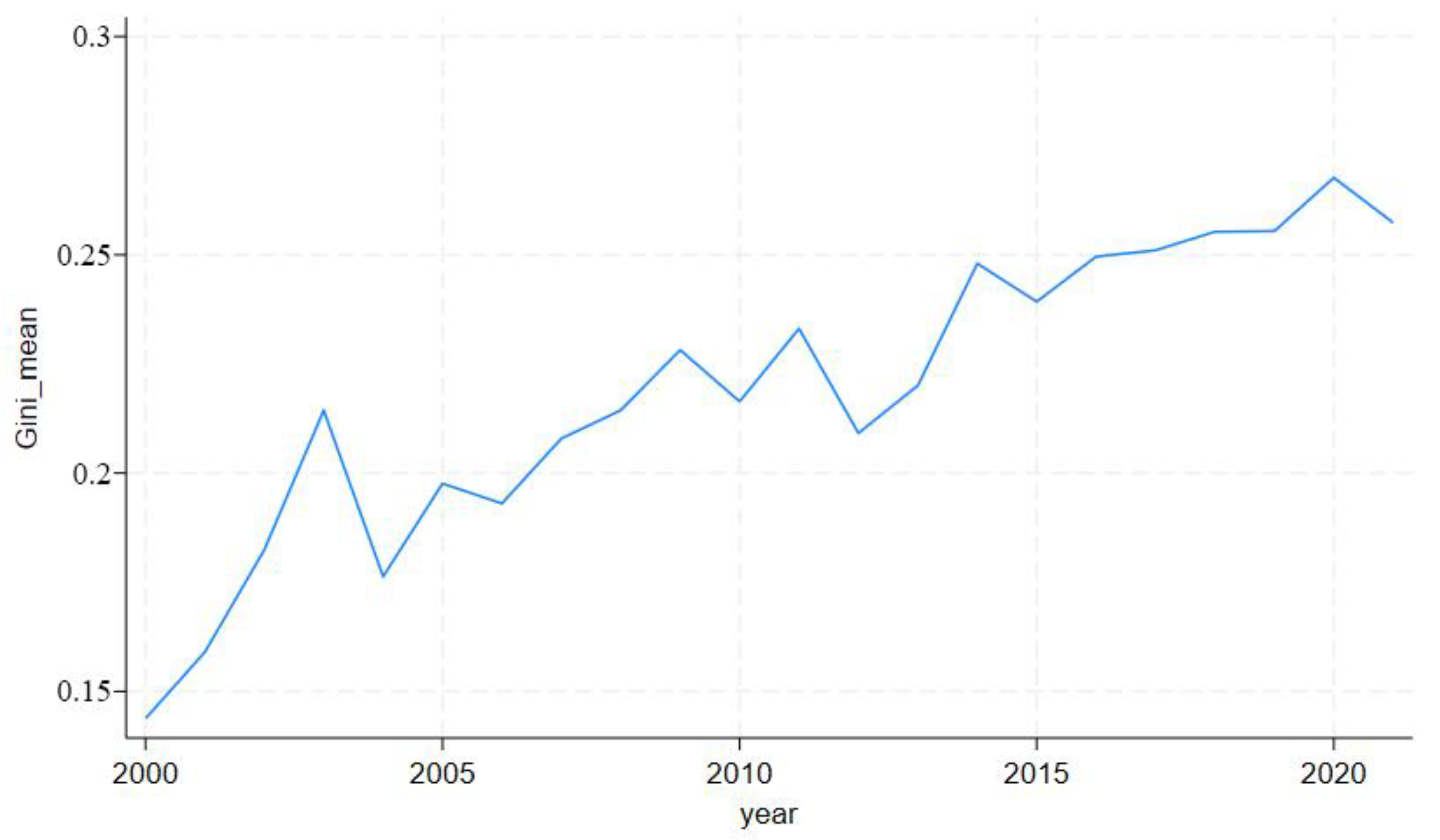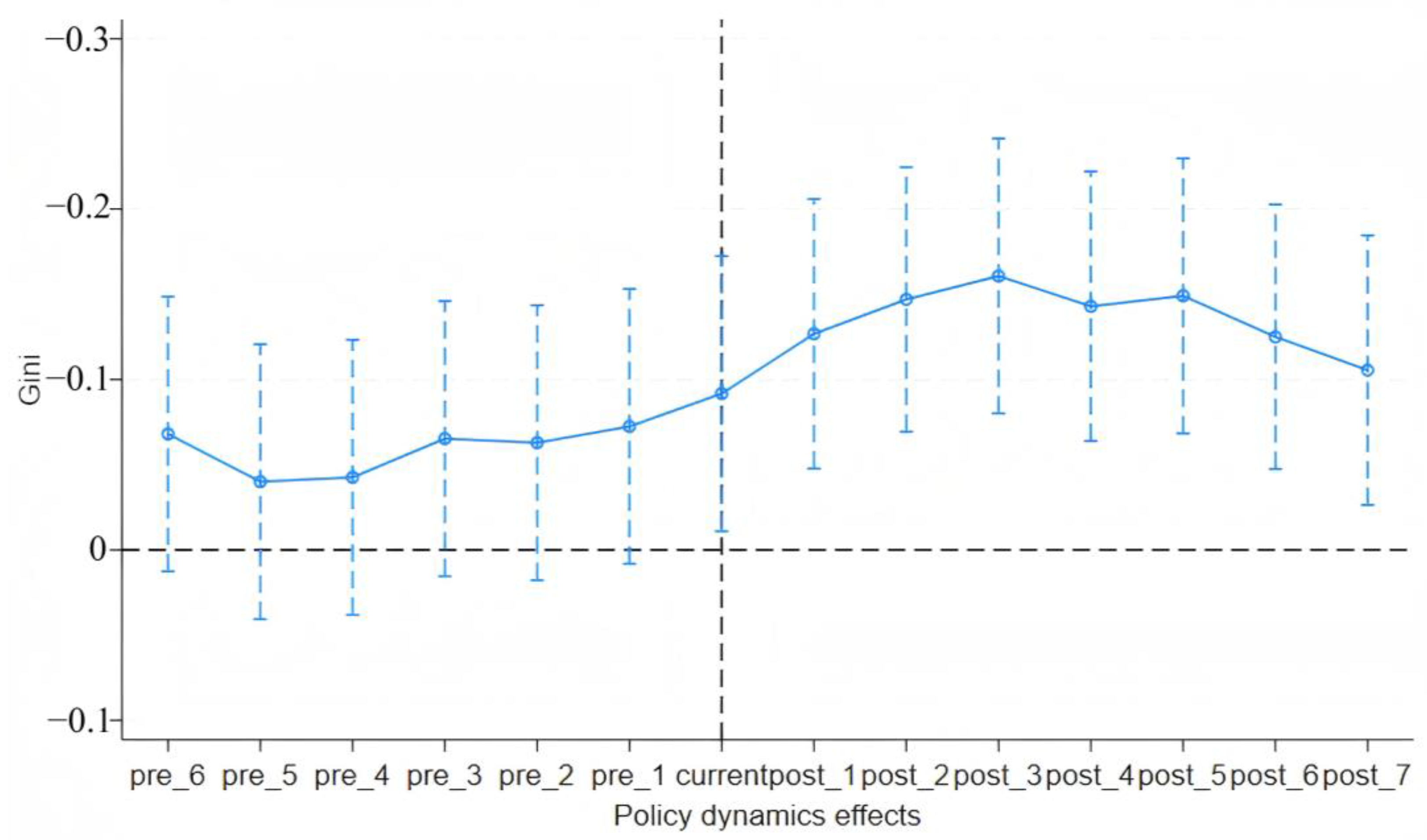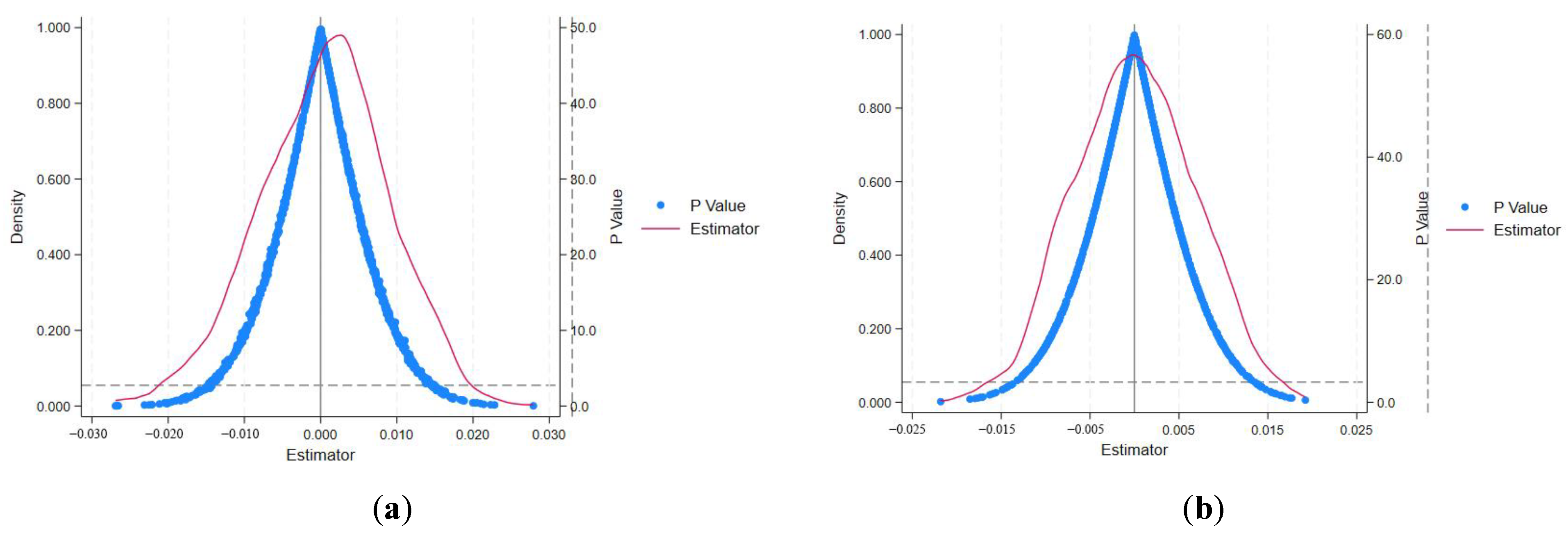New Energy Policies and Informal Cultural Norms Promoting Carbon Equity in Chinese Cities: Synergistic Effects and Regional Heterogeneity
Abstract
1. Introduction
2. Institutional Background and Theoretical Hypotheses
2.1. Institutional Background
2.2. Theoretical Hypotheses
3. Materials and Methods
3.1. Model Setting
3.1.1. Baseline Model
3.1.2. Regulatory Effect Model
3.2. Variable Selection
3.2.1. Explained Variable
3.2.2. Explanatory Variable
3.2.3. Moderating Variable
3.2.4. Control Variables
3.3. Data Specification
4. Results
4.1. Descriptive Statistics
4.2. Benchmark Regression
4.3. Parallel Trend Hypothesis Testing
4.4. Robustness Test
4.4.1. Placebo Test
4.4.2. Eliminate Concurrent Policy Interference
4.5. Further Analysis
4.5.1. The Moderating Effect of Confucianism
4.5.2. Heterogeneity Analysis
5. Discussion
5.1. Energy Transition and Carbon Equity
5.2. New Energy Policy and Informal Cultural Norms
5.3. Research Limitations and Future Prospects
6. Conclusions and Recommendations
6.1. Conclusions
6.2. Policy Recommendations
Author Contributions
Funding
Data Availability Statement
Conflicts of Interest
Abbreviations
| NEDC | New Energy Demonstration Cities; |
| CDM | Clean Development Mechanism. |
References
- Bieszk-Stolorz, B.; Dmytrów, K.; Pietrzak, M.B. Quality of Consumed Energy as a Key Element in the Development of Processes of Energy Transformation in the European Union Countries. Energies 2025, 18, 460. [Google Scholar] [CrossRef]
- Koufi, A.; Ziat, Y.; Belkhanchi, H. Study of the Gravimetric, Electronic and Thermoelectric Properties of XAlH3 (X= Be, Na, K) as hydrogen storage perovskite using DFT and the BoltzTrap Software Package. Sol. Energy Sustain. Dev. J. 2024, 2024, 53–66. [Google Scholar] [CrossRef]
- Laghlimi, C.; Moutcine, A.; Ziat, Y.; Belkhanchi, H.; Koufi, A.; Bouyassan, S. Hydrogen, Chronology and Electrochemical Production. Sol. Energy Sustain. Dev. J. 2024, 2024, 22–37. [Google Scholar] [CrossRef]
- He, Y.; Zhang, X.; Zhang, Y. Can new energy policy promote corporate total factor energy efficiency? Evidence from China’s new energy demonstration city pilot policy. Energy 2025, 318, 134782, ISSN 0360-5442. [Google Scholar] [CrossRef]
- Wang, N.; Qu, Z.; Li, J.; Zhang, Y.; Wang, H.; Xi, H.; Gu, Z. Spatial-temporal patterns and influencing factors of carbon emissions in different regions of China. Environ. Res. 2025, 276, 121447, ISSN 0013-9351. [Google Scholar] [CrossRef]
- Alvarez, D.I.; González-Ladrón-de-Guevara, F.; Rojas Espinoza, J.; Borge-Diez, D.; Galindo, S.P.; Flores-Vázquez, C. The Evolution of AI Applications in the Energy System Transition: A Bibliometric Analysis of Research Development, the Current State and Future Challenges. Energies 2025, 18, 1523. [Google Scholar] [CrossRef]
- Boyacı, S.; Kocięcka, J.; Jagosz, B.; Atılgan, A. Energy Efficiency in Greenhouses and Comparison of Energy Sources Used for Heating. Energies 2025, 18, 724. [Google Scholar] [CrossRef]
- Wei, C.; Ni, J.; Li, C. CO2 allocation and equity issues under China’s carbon neutrality targets: Recent advances and a review. China Econ. Rev. 2024, 83, 102108, ISSN 1043-951X. [Google Scholar] [CrossRef]
- Schmidt, V.A. Taking Ideas and Discourse Seriously: Theorizing Ideas and Their Use in the Study of Institutions. Ann. Am. Acad. Political Soc. Sci. 2010, 634, 126–148. [Google Scholar] [CrossRef]
- Ning, X.; Ye, X.; Pan, Y.; Li, Y.; Sun, H. Towards urban-rural development and equity in Western China: Insights gained from residential buildings’ carbon emissions and per capita income. Energy Sustain. Dev. 2025, 85, 101633, ISSN 0973-0826. [Google Scholar] [CrossRef]
- Pan, X.; Teng, F.; Du Pont, Y.R.; Wang, H. Understanding equity–efficiency interaction in the distribution of global carbon budgets. Adv. Clim. Change Res. 2023, 14, 13–22, ISSN 1674-9278. [Google Scholar] [CrossRef]
- Yang, M.; Liang, X.; Chen, H.; Ma, Y.; Aihemaiti, G. Regional carbon inequality prediction in China based on shared socioeconomic pathways: A human well-being equity perspective. Sustain. Prod. Consum. 2024, 50, 486–498, ISSN 2352-5509. [Google Scholar] [CrossRef]
- Tian, M.; Hu, Y.; Wang, H.; Li, C. Regional allowance allocation in China based on equity and efficiency towards achieving the carbon neutrality target: A composite indicator approach. J. Clean. Prod. 2022, 342, 130914, ISSN 0959-6526. [Google Scholar] [CrossRef]
- Zhou, R.; Guan, S.; He, B. The Impact of Trade Openness on Carbon Emissions: Empirical Evidence from Emerging Countries. Energies 2025, 18, 697. [Google Scholar] [CrossRef]
- Rao, A.; Kumar, S.; Gupta, P. Decarbonization dilemmas: Evaluating the impact on energy security and equity in emerging economies. Energy Econ. 2025, 145, 108448, ISSN 0140-9883. [Google Scholar] [CrossRef]
- Li, Y.; Wei, Y.; Zhang, X.; Tao, Y. Regional and provincial CO2 emission reduction task decomposition of China’s 2030 carbon emission peak based on the efficiency, equity and synthesizing principles. Struct. Change Econ. Dyn. 2020, 53, 237–256, ISSN 0954-349X. [Google Scholar] [CrossRef]
- Wang, Q.; Gao, Z.; Ning, J. Model-based assessment of the pattern differences and the equity of national carbon emissions in China during 2000–2010. J. Clean. Prod. 2015, 103, 696–704, ISSN 0959-6526. [Google Scholar] [CrossRef]
- Chen, F.; Lei, J.; Liu, Z.; Xiong, X. A Comparative Study on the Average CO2 Emission Factors of Electricity of China. Energies 2025, 18, 654. [Google Scholar] [CrossRef]
- Chaudary, M.S.A. Lithium dreams, local struggles: Navigating the geopolitics and socio-ecological costs of a low-carbon future. Energy Res. Soc. Sci. 2025, 121, 103952. [Google Scholar] [CrossRef]
- Wang, L.; Chen, S.; Wang, Y.; Wu, Y. From ancient philosophy to modern governance: Confucianism shaping low-carbon corporate transformation in China’s listed companies. J. Asian Econ. 2024, 95, 101835. [Google Scholar] [CrossRef]
- Dong, Z.; Li, H. The impact of Confucianism on the efficiency of enterprises green innovation. Financ. Res. Lett. 2023, 58, 104233. [Google Scholar] [CrossRef]
- Wang, X.; Lo, K. Civil society, environmental litigation, and Confucian energy justice: A case study of an environmental NGO in China. Energy Res. Soc. Sci. 2022, 93, 102831. [Google Scholar] [CrossRef]
- Yang, X.; Weber, A. Who can improve the environment—Me or the powerful others? An integrative approach to locus of control and pro-environmental behavior in China. Resour. Conserv. Recycl. 2019, 146, 55–67. [Google Scholar] [CrossRef]
- Birkin, F.; Margerison, J.; Monkhouse, L. Chinese environmental accountability: Ancient beliefs, science and sustainability. Resour. Environ. Sustain. 2021, 3, 100017. [Google Scholar] [CrossRef]
- Xu, Y.; Peng, J.; Tian, J.; Fu, S.; Hu, C.; Fu, S.; Feng, Y. The impact and mechanism analysis of Clean Development Mechanism on the synergistic effects of pollution mitigation and carbon reduction. Environ. Res. 2024, 260, 119659. [Google Scholar] [CrossRef]
- Hou, Y.; Yang, M.; Ma, Y.; Zhang, H. Study on city’s energy transition: Evidence from the establishment of the new energy demonstration cities in China. Energy 2024, 292, 130549. [Google Scholar] [CrossRef]
- Zhang, Q.; Huang, X.; Xu, Y.; Bhuiyan, M.A.; Liu, P. New energy demonstration city pilot and green energy consumption: Evidences from China. Energy Rep. 2022, 8, 7735–7750. [Google Scholar] [CrossRef]
- Che, S.; Wang, J.; Chen, H. Can China’s decentralized energy governance reduce carbon emissions? Evidence from new energy demonstration cities. Energy 2023, 284, 128665. [Google Scholar] [CrossRef]
- Wu, J.; Zuidema, C.; Gugerell, K. Experimenting with decentralized energy governance in China: The case of New Energy Demonstration City program. J. Clean. Prod. 2018, 189, 830–838. [Google Scholar] [CrossRef]
- Zhang, Z.; Luo, C.; Zhang, G.; Shu, Y.; Shao, S. New energy policy and green technology innovation of new energy enterprises: Evidence from China. Energy Econ. 2024, 136, 107743. [Google Scholar] [CrossRef]
- Wang, Q.; Yi, H. New energy demonstration program and China’s urban green economic growth: Do regional characteristics make a difference? Energy Policy 2021, 151, 112161. [Google Scholar] [CrossRef]
- Manta, A.G.; Gherțescu, C.; Bădîrcea, R.M.; Manta, L.F.; Popescu, J.; Lăpădat, C.V.M. How Does the Interplay Between Banking Performance, Digitalization, and Renewable Energy Consumption Shape Sustainable Development in European Union Countries? Energies 2025, 18, 571. [Google Scholar] [CrossRef]
- Zhao, C.; Dong, K.; Lee, C.-C. Carbon lock-in endgame: Can energy trilemma eradication contribute to decarbonization? Energy 2024, 293, 130662. [Google Scholar] [CrossRef]
- Kung, J.K.S.; Ma, C. Can cultural norms reduce conflicts? Confucianism and peasant rebellions in Qing China. J. Dev. Econ. 2014, 111, 132–149. [Google Scholar] [CrossRef]
- Chen, S.; Chen, Y.; Jebran, K. Trust and corporate social responsibility: From expected utility and social normative perspective. J. Bus. Res. 2021, 134, 518–530. [Google Scholar] [CrossRef]
- Wang, Y.; Chen, Y. Confucianism and farmers’ pro-environmental behaviors: Self-interest or mutual benefit? J. Environ. Psychol. 2025, 102, 102548. [Google Scholar] [CrossRef]
- Chen, L.; Duan, L. Can informal environmental regulation restrain air pollution? Evidence from media environmental coverage. J. Environ. Manag. 2025, 377, 124637. [Google Scholar] [CrossRef]
- Ip, E.C. Planetary health ethics: A Confucian alternative. J. Clim. Change Health 2025, 22, 100404. [Google Scholar] [CrossRef]
- Cheng, M.; Fan, Z.; Feng, C.; Tian, B. Cultural norms and tax compliance: Evidence from China. J. Econ. Behav. Organ. 2024, 227, 106720. [Google Scholar] [CrossRef]
- Wan, J.; Wang, Y.; Wang, Y. Promoting or Hindering: The Impact of ESG Rating Differences on Energy Enterprises’ Green Transformation—A Causal Test from Double Machine-Learning Algorithms. Energies 2025, 18, 464. [Google Scholar] [CrossRef]
- Pfaff, A.; Velez, M.A.; Broad, K.; Hamoudi, A.; Taddei, R. Contracts versus trust for transfers of ecosystem services: Equity and efficiency in resource allocation and environmental provision. Water Resour. Econ. 2019, 28, 100118. [Google Scholar] [CrossRef]
- Tian, Y. Will Informal Institutions Affect ESG Rating Divergence? Evidence from Chinese Confucian Culture. Sustainability 2024, 16, 9951. [Google Scholar] [CrossRef]
- Chen, H.; Shen, Q.; Li, H. Settlement and the nature of the dawn: The influence of Confucianism on farmers’ migrant labor. Contemp. Econ. Sci. 2021, 43, 124–132. [Google Scholar] [CrossRef]
- Chen, T.; Kung, J.K.S.; Ma, C.C. Long live Keju! The persistent effects of China’s civil examination system. Econ. J. 2020, 130, 2030–2064. [Google Scholar] [CrossRef]
- Zhang, Y.; Huang, H. The impact of digital economy development on inequity of carbon emissions. Resour. Sci. 2023, 45, 1223–1238. [Google Scholar] [CrossRef]
- Qian, Y.; Pu, Z. Can digital innovation reduce carbon inequality within cities? China Popul. Resour. Environ. 2019, 34, 64–74. [Google Scholar] [CrossRef]
- Fraser, T.; Chapman, A.J.; Shigetomi, Y. Leapfrogging or lagging? Drivers of social equity from renewable energy transitions globally. Energy Res. Soc. Sci. 2023, 98, 103006. [Google Scholar] [CrossRef]
- Lee, C.; Ogata, S. Every coin has two sides: Dual effects of energy transition on regional sustainable development—A quasi-natural experiment of the New Energy Demonstration City Pilot Policy. Appl. Energy 2025, 390, 125772. [Google Scholar] [CrossRef]
- Hua, W.; Wu, Z.; Gao, C.; Luo, L. Sustaining resource-oriented sanitation behaviors through informal institutions: Evidence from China. J. Clean. Prod. 2023, 425, 138886. [Google Scholar] [CrossRef]
- Yu, Z.; Wang, Z.; Ma, M.; Ma, L. The impact of carbon leakage from energy-saving targets: A moderating effect based on new-energy model cities. Appl. Energy 2024, 375, 124113. [Google Scholar] [CrossRef]
- Park, M.; Chesla, C. Revisiting Confucianism as a conceptual framework for Asian family study. J. Fam. Nurs. 2007, 13, 293–311. [Google Scholar] [CrossRef] [PubMed]
- Wu, L.; Wang, G. Fairness, Trust, and Well-Being Among Young Adults: Evidence from 2021 Chinese General Social Survey (CGSS). Healthcare 2024, 12, 2186. [Google Scholar] [CrossRef] [PubMed]
- Dong, X.; Zhang, J.F. Heterogeneity of regional carbon emission markets in China: Evidence from multidimensional determinants. Energy Econ. 2024, 138, 107835. [Google Scholar] [CrossRef]
- Xing, P.; Wang, Y.; Ye, T.; Sun, Y.; Li, Q.; Li, X.; Li, M.; Chen, W. Carbon emission efficiency of 284 cities in China based on machine learning approach: Driving factors and regional heterogeneity. Energy Econ. 2024, 129, 107222. [Google Scholar] [CrossRef]
- Mao, Q.; Mao, X. The shaping of inter-regional industrial linkages by institutional and cultural division in China: Characteristics and differences. Econ. Anal. Policy 2024, 81, 1113–1132. [Google Scholar] [CrossRef]
- Dong, S.; Wang, X.C.; Dong, X.; Kong, F. Unsustainable imbalances in urbanization and ecological quality in the old industrial base province of China. Ecol. Indic. 2024, 158, 111441. [Google Scholar] [CrossRef]
- Chen, J.; Liu, S.; Zhang, X. Resources coupled with executive authority: Implications of relocating government administrative headquarters for local economic development. World Dev. 2025, 185, 106798. [Google Scholar] [CrossRef]
- Xiong, Y.; Tian, X.; Kang, A. A fine-scale atlas reveals the systematic imbalance between carbon emissions and economic benefits along value chain within China. Sci. Total Environ. 2024, 957, 177311. [Google Scholar] [CrossRef]
- Wu, W.; Zhang, N.; Li, A.; Chen, Y. The path to global climate justice: From the perspective of regional discrepancy in embodied carbon emissions. Environ. Impact Assess. Rev. 2024, 105, 107410. [Google Scholar] [CrossRef]
- Goggins, G.; Rau, H.; Moran, P.; Fahy, F.; Goggins, J. The role of culture in advancing sustainable energy policy and practice. Energy Policy 2022, 167, 113055. [Google Scholar] [CrossRef]
- Li, X. Local government decision-making competition and regional carbon emissions: Experience evidence and emission reduction measures. Sustain. Energy Technol. Assess. 2022, 50, 101800. [Google Scholar] [CrossRef]
- Zhang, N.; Bo, L.; Wang, X. Confucianism and corporate default risk: Assessing the governance influence of traditional culture. Int. Rev. Econ. Finance 2024, 94, 103378. [Google Scholar] [CrossRef]






| (1) | (2) | |
|---|---|---|
| Gini | Gini | |
| did | 0.032 ** | 0.027 * |
| (0.016) | (0.015) | |
| Dev. | 0.002 * | |
| (0.001) | ||
| Income | 0.091 *** | |
| (0.013) | ||
| Str. | 0.006 | |
| (0.010) | ||
| Invest | −0.057 ** | |
| (0.024) | ||
| FDI | −0.084 ** | |
| (0.035) | ||
| Fsc. | 0.358 *** | |
| (0.039) | ||
| Constant | 0.341 *** | −0.465 *** |
| (0.004) | (0.119) | |
| Control variables | No | Yes |
| Year FE | Yes | Yes |
| City FE | Yes | Yes |
| Prov. × Year | Yes | Yes |
| Obs. | 3678 | 3678 |
| R2 | 0.071 | 0.165 |
| (1) | (2) | (3) | (4) | (5) | (6) | |
|---|---|---|---|---|---|---|
| Broadband | Green Finance | Fiscity | ||||
| did × Conf. | −0.030 ** | −0.031 ** | −0.030 ** | |||
| (0.013) | (0.013) | (0.013) | ||||
| did | 0.027 * | 0.047 ** | 0.027 * | 0.049 ** | 0.029 * | 0.049 ** |
| (0.015) | (0.022) | (0.015) | (0.022) | (0.015) | (0.022) | |
| Dev. | 0.002 * | 0.001 | 0.002 * | 0.001 | 0.003 ** | 0.001 |
| (0.001) | (0.001) | (0.001) | (0.001) | (0.001) | (0.001) | |
| Income | 0.094 *** | 0.095 *** | 0.091 *** | 0.099 *** | 0.090 *** | 0.100 *** |
| (0.013) | (0.018) | (0.013) | (0.018) | (0.013) | (0.018) | |
| Str. | 0.005 | −0.018 ** | 0.006 | −0.018 ** | 0.008 | −0.017 ** |
| (0.010) | (0.009) | (0.010) | (0.009) | (0.010) | (0.009) | |
| Invest | −0.056 ** | −0.070 *** | −0.057 ** | −0.070 *** | −0.057 ** | −0.070 *** |
| (0.024) | (0.012) | (0.024) | (0.012) | (0.024) | (0.012) | |
| FDI | −0.082 ** | −0.004 | −0.084 ** | −0.002 | −0.085 ** | −0.002 |
| (0.035) | (0.025) | (0.035) | (0.025) | (0.035) | (0.025) | |
| Fsc. | 0.362 *** | −0.007 | 0.358 *** | −0.009 | 0.352 *** | −0.009 |
| (0.039) | (0.029) | (0.039) | (0.029) | (0.039) | (0.029) | |
| did × Broadland | −0.030 * | −0.013 | ||||
| (0.016) | (0.009) | |||||
| did × GF | 0.039 | −0.002 | ||||
| (0.077) | (0.043) | |||||
| did × Fiscity | 0.078 *** | 0.042 *** | ||||
| (0.023) | (0.015) | |||||
| Constant | −0.492 *** | −0.587 *** | −0.465 *** | −0.630 *** | −0.465 *** | −0.644 *** |
| (0.120) | (0.179) | (0.119) | (0.176) | (0.119) | (0.176) | |
| Control variables | Yes | Yes | Yes | Yes | Yes | Yes |
| Year FE | Yes | Yes | Yes | Yes | Yes | Yes |
| City FE | Yes | Yes | Yes | Yes | Yes | Yes |
| Prov. × Year | Yes | Yes | Yes | Yes | Yes | Yes |
| Obs. | 3678 | 3678 | 3678 | 3678 | 3678 | 3678 |
| R2 | 0.166 | 0.802 | 0.165 | 0.802 | 0.168 | 0.802 |
| (1) | (2) | (3) | (4) | |
|---|---|---|---|---|
| Gini | Gini | Gini | Gini | |
| did × Conf. | −0.033 ** | −0.031 ** | −0.035 *** | −0.036 *** |
| (0.013) | (0.013) | (0.013) | (0.013) | |
| did | 0.055 ** | 0.049 ** | 0.054 ** | 0.054 ** |
| (0.022) | (0.022) | (0.022) | (0.022) | |
| Grade × year | 0.006 *** | |||
| (0.001) | ||||
| Centre × year | 0.005 *** | |||
| (0.001) | ||||
| Constant | 0.344 *** | −0.630 *** | −1.678 *** | −1.690 *** |
| (0.002) | (0.176) | (0.291) | (0.315) | |
| Control variables | No | Yes | Yes | Yes |
| Year FE | Yes | Yes | Yes | Yes |
| City FE | Yes | Yes | Yes | Yes |
| Prov. × Year | Yes | Yes | Yes | Yes |
| Obs. | 3678 | 3678 | 3653 | 3653 |
| R2 | 0.798 | 0.802 | 0.803 | 0.802 |
| (1) | (2) | (3) | (4) | |
|---|---|---|---|---|
| Gini | Gini | Gini | Gini | |
| did × Conf. 1 | −0.247 ** | −0.245 ** | −0.281 *** | −0.274 *** |
| (0.097) | (0.097) | (0.097) | (0.097) | |
| did | 0.120 ** | 0.120 ** | 0.137 *** | 0.133 *** |
| (0.051) | (0.051) | (0.051) | (0.051) | |
| Grade × year | 0.010 *** | |||
| (0.003) | ||||
| Centre × year | 0.008 *** | |||
| (0.003) | ||||
| Constant | 0.361 *** | −0.667 *** | −2.316 *** | −2.399 *** |
| (0.003) | (0.255) | (0.560) | (0.641) | |
| Control variables | No | Yes | Yes | Yes |
| Year FE | Yes | Yes | Yes | Yes |
| City FE | Yes | Yes | Yes | Yes |
| Obs. | 1846 | 1846 | 1846 | 1846 |
| R2 | 0.797 | 0.800 | 0.801 | 0.801 |
| (1) | (2) | (3) | (4) | |
|---|---|---|---|---|
| Non-Old Industrial Base | Old Industrial Base | Non-Resource-Dependent | Resource-Dependent | |
| did × Conf. | −0.097 *** | −0.030 | −0.054 *** | −0.012 |
| (0.017) | (0.033) | (0.019) | (0.021) | |
| did | 0.149 *** | 0.122 ** | 0.070 ** | 0.029 |
| (0.030) | (0.048) | (0.032) | (0.034) | |
| Constant | 0.365 * | −0.402 | −0.237 | −1.475 *** |
| (0.214) | (0.273) | (0.232) | (0.334) | |
| Control variables | Yes | Yes | Yes | Yes |
| Year FE | Yes | Yes | Yes | Yes |
| City FE | Yes | Yes | Yes | Yes |
| Prov. × Year | Yes | Yes | Yes | Yes |
| Obs. | 2412 | 1209 | 2204 | 1414 |
| R2 | 0.804 | 0.175 | 0.786 | 0.819 |
Disclaimer/Publisher’s Note: The statements, opinions and data contained in all publications are solely those of the individual author(s) and contributor(s) and not of MDPI and/or the editor(s). MDPI and/or the editor(s) disclaim responsibility for any injury to people or property resulting from any ideas, methods, instructions or products referred to in the content. |
© 2025 by the authors. Licensee MDPI, Basel, Switzerland. This article is an open access article distributed under the terms and conditions of the Creative Commons Attribution (CC BY) license (https://creativecommons.org/licenses/by/4.0/).
Share and Cite
Yang, Z.; Yu, H.; Zhang, J. New Energy Policies and Informal Cultural Norms Promoting Carbon Equity in Chinese Cities: Synergistic Effects and Regional Heterogeneity. Energies 2025, 18, 2475. https://doi.org/10.3390/en18102475
Yang Z, Yu H, Zhang J. New Energy Policies and Informal Cultural Norms Promoting Carbon Equity in Chinese Cities: Synergistic Effects and Regional Heterogeneity. Energies. 2025; 18(10):2475. https://doi.org/10.3390/en18102475
Chicago/Turabian StyleYang, Zixuan, Huang Yu, and Jingqiu Zhang. 2025. "New Energy Policies and Informal Cultural Norms Promoting Carbon Equity in Chinese Cities: Synergistic Effects and Regional Heterogeneity" Energies 18, no. 10: 2475. https://doi.org/10.3390/en18102475
APA StyleYang, Z., Yu, H., & Zhang, J. (2025). New Energy Policies and Informal Cultural Norms Promoting Carbon Equity in Chinese Cities: Synergistic Effects and Regional Heterogeneity. Energies, 18(10), 2475. https://doi.org/10.3390/en18102475





